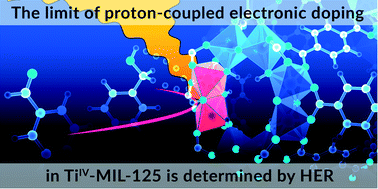On the limit of proton-coupled electronic doping in a Ti(iv)-containing MOF†
Abstract
TiIV-containing metal–organic frameworks are known to accumulate electrons in their conduction bands, accompanied by protons, when irradiated in the presence of alcohols. The archetypal system, MIL-125, was recently shown to reach a limit of 2e− per Ti8 octomeric node. However, the origin of this limit and the broader applicability of this unique chemistry relies not only on the presence of TiIV, but also access to inorganic inner-sphere Lewis basic anions in the MOF nodes. Here, we study the loading of protons and electrons in MIL-125, and assess the thermodynamic limit of doping these materials. We find that the limit is determined by the reduction potential of protons: in high charging regimes the MOF exceeds the H+/H2 potential. Generally, we offer the design principle that inorganic anions in MOF nodes can host adatomic protons, which may stabilize meta-stable low valent transition metals. This approach highlights the unique chemistry afforded by MOFs built from inorganic clusters, and provides one avenue to developing novel catalytic scaffolds for hydrogen evolution and transfer hydrogenation.



 Please wait while we load your content...
Please wait while we load your content...